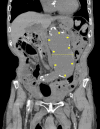Tranexamic Acid Ameliorated Bleeding Tendency in Abdominal Aortic Aneurysm-Induced Chronic Disseminated Intravascular Coagulation
- PMID: 40568273
- PMCID: PMC12188696
- DOI: 10.7759/cureus.84822
Tranexamic Acid Ameliorated Bleeding Tendency in Abdominal Aortic Aneurysm-Induced Chronic Disseminated Intravascular Coagulation
Abstract
An 84-year-old man with a history of cerebral infarction, inoperable abdominal aortic aneurysm (AAA), and chronic kidney disease-related anemia was admitted for rehabilitation. He had experienced recurrent gastrointestinal bleeding before admission, initially attributed to dual antiplatelet therapy. After admission, progressive subcutaneous hemorrhage developed, prompting detailed coagulation-fibrinolysis testing, which confirmed chronic disseminated intravascular coagulation (DIC) (enhanced-fibrinolytic type) secondary to AAA. Given his advanced age and overall condition, oral tranexamic acid was initiated, resulting in hemorrhage improvement and stabilization of coagulation parameters. Retrospective evaluation suggested that prior gastrointestinal bleeding episodes were more likely attributable to chronic DIC. This case highlights the importance of considering chronic DIC in patients with recurrent, unexplained bleeding, even when they have been evaluated by multiple specialists, and suggests that individualized antifibrinolytic therapy, although not standard, may serve as a practical and familiar option for general internists in carefully selected inoperable elderly patients.
Keywords: abdominal aortic aneurysm; bleeding tendency; chronic disseminated intravascular coagulation; enhanced-fibrinolytic type; tranexamic acid.
Copyright © 2025, Miwa et al.
Conflict of interest statement
Human subjects: Consent for treatment and open access publication was obtained or waived by all participants in this study. Conflicts of interest: In compliance with the ICMJE uniform disclosure form, all authors declare the following: Payment/services info: All authors have declared that no financial support was received from any organization for the submitted work. Financial relationships: All authors have declared that they have no financial relationships at present or within the previous three years with any organizations that might have an interest in the submitted work. Other relationships: All authors have declared that there are no other relationships or activities that could appear to have influenced the submitted work.
Figures



Similar articles
-
Antifibrinolytics for heavy menstrual bleeding.Cochrane Database Syst Rev. 2000;(4):CD000249. doi: 10.1002/14651858.CD000249. Cochrane Database Syst Rev. 2000. Update in: Cochrane Database Syst Rev. 2018 Apr 15;4:CD000249. doi: 10.1002/14651858.CD000249.pub2. PMID: 11034679 Updated.
-
Intravenous magnesium sulphate and sotalol for prevention of atrial fibrillation after coronary artery bypass surgery: a systematic review and economic evaluation.Health Technol Assess. 2008 Jun;12(28):iii-iv, ix-95. doi: 10.3310/hta12280. Health Technol Assess. 2008. PMID: 18547499
-
Drugs to reduce bleeding and transfusion in major open vascular or endovascular surgery: a systematic review and network meta-analysis.Cochrane Database Syst Rev. 2023 Feb 17;2(2):CD013649. doi: 10.1002/14651858.CD013649.pub2. Cochrane Database Syst Rev. 2023. PMID: 36800489 Free PMC article.
-
Decreased factor XIII activity and haptoglobin may be markers of enhanced-fibrinolytic-type disseminated intravascular coagulation status: Case report.Medicine (Baltimore). 2025 Jul 25;104(30):e43123. doi: 10.1097/MD.0000000000043123. Medicine (Baltimore). 2025. PMID: 40725922 Free PMC article.
-
Non-surgical interventions for treating heavy menstrual bleeding (menorrhagia) in women with bleeding disorders.Cochrane Database Syst Rev. 2016 Nov 10;11(11):CD010338. doi: 10.1002/14651858.CD010338.pub3. Cochrane Database Syst Rev. 2016. PMID: 27841443 Free PMC article.
References
-
- Effect of combined therapy of danaparoid sodium and tranexamic acid on chronic disseminated intravascular coagulation associated with abdominal aortic aneurysm. Ontachi Y, Asakura H, Arahata M, et al. Circ J. 2005;69:1150–1153. - PubMed
Publication types
LinkOut - more resources
Full Text Sources
